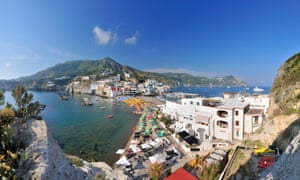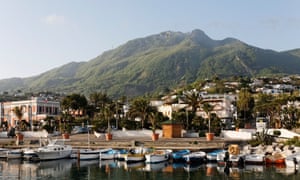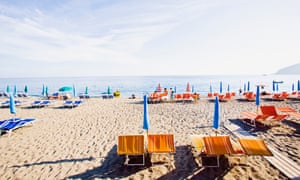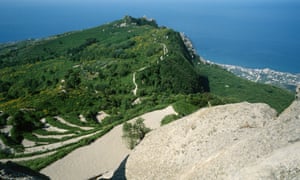 |
| The angel’s share … picturesque Sant’Angelo, Ischia. Photograph: Alamy Stock Photo |
A short ferry ride from Naples, Ischia’s rustic villages – wonderfully evoked by the Italian novelist – have retained their charm and beauty
Few works of fiction have captured the sultry grittiness of southern Italy like Elena Ferrante’s wildly successful Neapolitan quartet, which concluded this month with the English translation of The Story of the Lost Child. Ferrante’s 1950s Naples is a chaotic mire of sweat and stymied ambition – a place her characters all struggle to escape. But with a hop across the Gulf of Naples, Ferrante transports readers to paradise.
A one-hour ferry ride from the city, Ischia is a 17-square-mile island of parched tufa and bougainvillea that has hardly changed since the languid summers when Ferrante’s teenage protagonists – fleeing Naples’ stultifying heat and poverty – discover their respective sexualities on the thermal beach at Maronti. Even today, the majority of visitors to Ischia are Italians; many, like Ferrante’s Elena and Lila, are Neapolitans from across the bay, often returning to the same guesthouses and rental apartments every year, each summer a chance to catch up with old friends.
And although the island’s larger towns – Ischia Porto, Forio, and Lacco Ameno – have turned into an even more rarefied imitation of nearby Capri (rooms at theAlbergo della Regina Isabella, beloved by Richard Burton and Elizabeth Taylor, can cost £384 a night), its villages still evoke the languid days of Ferrante’s heroines.
Mules may no longer hoist suitcases up the steep hills of Sant’Angelo – a white-washed village of gelaterias and ceramic shops, a 20-minute walk from where Ferrante’s Elena lost her virginity on a moonlit beach – but the village is still car-free: only the odd miniature luggage truck is allowed through the narrow streets. On the hilltop is the Casa Garibaldi B&B (doubles from £55), a sprawling family-run garden complex of mosaicked terraces and thermal pools. Owner Luisa Iacono saves the same rooms for the same regulars every year, while her mother, Giuseppina, has been making the same special brioche for weekend breakfasts since the 1990s. Along the Maronti seafront, tables at Ristorante Emmanuela are fully booked by 10am. While Emmanuela herself has retired from the kitchen – replaced by various children and eager in-laws, she still maintains tasting rights over her signature spaghetti all’Emmanuela – fresh rock-caught shellfish tossed in a tomato sauce that, as with most sauces in Italy’s south, betrays a hint of piquantpeperoncino (chilli).
A few minutes’ walk up a hillside path dotted with darting lizards, the sea-facing thermal pool complex at Aphrodite Apollon evokes an extended classical ruin: the flower-draped pools – each named after a Greco-Roman deity – are all but dissolving into the cliffside. But for those in search of a more organic spa experience, a 40-minute hike through volcanic gorges leads to Cavascura, a tiny shack-like spa over thermal springs whose use dates back to Roman times. Massages here are still done with fango (therapeutic mud), the saunas are built into the cave, and the water for the showers is warmed by the springs themselves.
That’s not to say Sant’Angelo is excessively traditionalist. At dusk, visitors and locals fill the town square, and bars such as the eclectic if pricey Tavernetta del Pirata – something between a ceramic shop and a 1950s-style American piano bar – overflow with revellers seeking chilled limoncello and genial raucousness.
A few diners and yachting daytrippers in search of a more formal evening head to the elegantly minimalist Neptunus along the coast, but everybody else heads to the gregariously crowded pizzerias. Regulars swear by intimate Da Pasquale. The narrow isthmus that connects the old town to a marina beneath a gargantuan stone outcrop becomes a kind of bar of its own, as teenagers share gelatos (locals go to Pasticceria Dolce è la Vita just behind the main square) and cigarettes under the stars.
But Ischia’s greatest enchantment lies not in its villages, nor even in the shimmering of its seaside – but in its hills, where few tourists venture. Around the 789-metre Monte Epomeo, Ischia’s landscape changes dramatically. Dusty cliffs and flowers give way to brambles, white lava and darkly green vineyards.
Most visitors to Ischia’s mountain tend to do as Ferrante’s Elena and her unworthy beloved Nino did and make straight for the top of Epomeo – an hour-long scramble from the village of Fontana, to be rewarded not just by sea views but by lunch at La Grotta da Fiore, which is carved into the soft volcanic rock. But a longer stay – wandering the many narrow lanes that wind off the island’s single ring road – yields more of Ischia’s secrets. The hamlets between Sant’Angelo and Epomeo – Serrara, Fontana, Noia – are simple, geometric villages: each with pale painted houses, a 19th-century church with painted statues of Mary and the archangels and one or two bars for espressos and fresh spremuta d’arancia (orange juice).
Up here the food is different, too: not seafood but fresh mountain rabbit, preparedall’ischitana, with fresh herbs and fresher tomatoes. The vine-strewn restaurants here are often deserted – for lunch, it can be necessary to call (and secure a rabbit) in advance. At the best of these, Il Comignolo, such a telephone call procures a whole-day affair: rabbit transformed first into an earthy sugo (sauce) for chewybucatini (spaghetti with a hole through the middle,) then served for main course in a still-sizzling stew (dessert is grapes, fresh-picked from the terrace).
Moments before embarking on her first affair, Ferrante’s narrator, Elena Greco, contemplates the sensual idleness of the island. “Now the moon was visible amid scattered pale-edged clouds; the evening was very fragrant, and you could hear the hypnotic rhythm of the waves.”
Nothing much has changed.
• EasyJet and Thompson fly to Naples from several UK airports. Ferry crossings from Naples to Ischia take around an hour, adult return from €37
By Tara Isabella Burton, www.theguardian.com




No comments:
Post a Comment